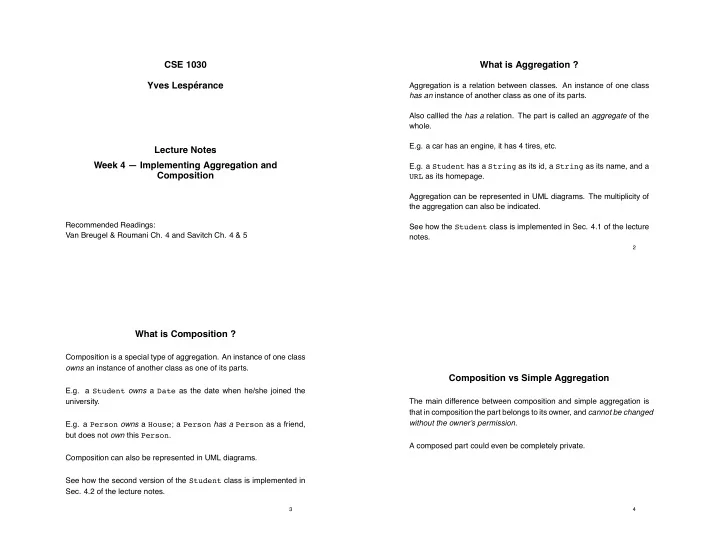

CSE 1030 What is Aggregation ? Yves Lesp´ erance Aggregation is a relation between classes. An instance of one class has an instance of another class as one of its parts. Also callled the has a relation. The part is called an aggregate of the whole. E.g. a car has an engine, it has 4 tires, etc. Lecture Notes Week 4 — Implementing Aggregation and E.g. a Student has a String as its id, a String as its name, and a Composition URL as its homepage. Aggregation can be represented in UML diagrams. The multiplicity of the aggregation can also be indicated. Recommended Readings: See how the Student class is implemented in Sec. 4.1 of the lecture Van Breugel & Roumani Ch. 4 and Savitch Ch. 4 & 5 notes. 2 What is Composition ? Composition is a special type of aggregation. An instance of one class owns an instance of another class as one of its parts. Composition vs Simple Aggregation E.g. a Student owns a Date as the date when he/she joined the university. The main difference between composition and simple aggregation is that in composition the part belongs to its owner, and cannot be changed without the owner’s permission . E.g. a Person owns a House ; a Person has a Person as a friend, but does not own this Person . A composed part could even be completely private. Composition can also be represented in UML diagrams. See how the second version of the Student class is implemented in Sec. 4.2 of the lecture notes. 3 4
This becomes an issue when the part is mutable, e.g. Date for Student . A privacy leak also occurs if a mutator or constructor assigns a mutable object that the client has a reference to to an owned attribute, e.g. If an accessor returns a reference to the actual part, the client can Date for Student . mutate it. This is the case even if the attribute, e.g. joinDate is private. Then the client can still mutate the object, without the owner’s permis- sion. This results in a privacy leak . To avoid this, the mutator/constructor can make a copy of the object To avoid this, the accessor can return a copy of the part rather than before assigning it to the owned attribute. the original. Then the client does not have a reference to the copy of the object in The client can then mutate the copy, but not the original part. the owned attribute, so it cannot mutate it. 5 6 Deep vs Shallow Copying In summary, to implement composition where the owned part is a mu- When making a copy of an object that owns other mutable objects, it is table object: important to make copies of the parts as well, so that the copy and the original do not share parts. 1) we make the attribute for the owned part private; This is called making a deep copy . 2) we make the mutators/constructors make a copy of the argument object and assign this copy to the attribute; and If you only copy the references to the parts, you are making a shallow copy , and the copy and the original share the parts. 3) we make the accessors return a copy of the owned attribute object. Then mutating one part mutates the other. 7 8
Collections In many case, an object has a whole collection of components, e.g. a Portfolio has a collection of Investment s (seen in Java By Ab- The Collection Framework straction), a Course has a collection of Student s, a Student has a collection of Courses it has taken. Interface Set<T> implemented by HashSet<T> and TreeSet<T> ; order does not matter and no duplicates. In math, the main corresponding structuring mechanism is sets. Interface List<T> implemented by ArrayList<T> and LinkedList<T> ; In Java, there are several mechanisms to deal with collections, in par- order matters and duplicates are allowed. ticular, arrays and the classes in the Collection Fremework. Interface Map<Tkey,Tval> implemented by HashMap<Tkey,Tval> Can use UML class diagrams to represent having a collection of com- and TreeMap<Tkey,Tval> , representing a function from Tkey to Tval. ponents . The multiplicity of has-a relationship can be *, i.e. 0 or more compo- nents. 9 10 Iteration over Collections Often you need to do some operations on each element of a collection. This is called iterating over the collection. Classes that have collections as part provide ways to iterate over their elements. iterator() method of Set<T> and List<T> returns an Iterator<T> object. Can get successive elements by calling next() on iterator. Can check whether there are more elements by calling hasNext() on iterator; returns true iff there are more elements. 11
Recommend
More recommend